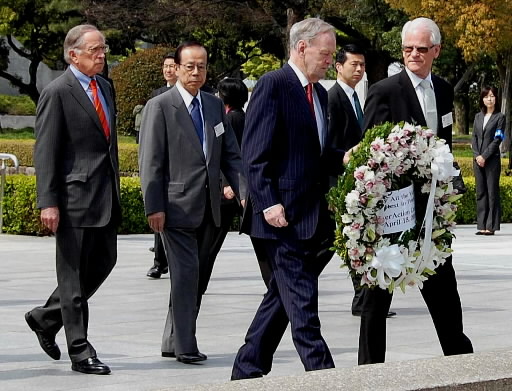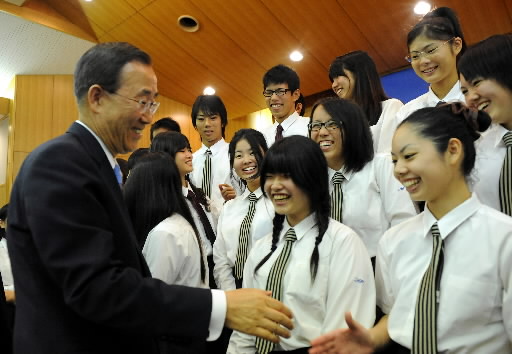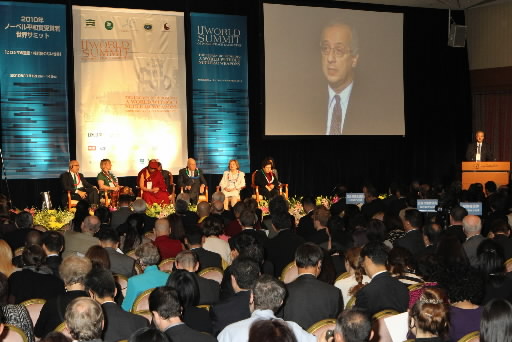Remarks by visitors to Hiroshima in 2010, the 65th anniversary of the atomic bombing
Dec. 26, 2010
by Noritaka Egusa, Editor and Senior Staff Writer
During the course of this year, which marked the 65th anniversary of the atomic bombing, various people from both Japan and abroad visited Hiroshima. On August 6, Ban Ki-moon, United Nations Secretary-General, and John Roos, U.S. ambassador to Japan, became the first people holding their posts to attend Hiroshima’s Peace Memorial Ceremony. And with “The 2010 World Summit of Nobel Peace Laureates” in November and other gatherings that were held here, many leaders in the global peace movement visited the city this year. What did those who came to Hiroshima feel after they were exposed to the facts surrounding the atomic bombing and what did they have to say about their experiences? The Chugoku Shimbun looked back at the statements of visitors to the city over the past year.
U.N. Secretary-General Ban: Replace Flame of Peace with light of hope
Prime Minister Kan: Nuclear deterrence is necessary
U.S. Ambassador Roos departs without comment
Nobel Peace Prize winners call on citizens to take action
At the Peace Memorial Ceremony on August 6, Mr. Ban gave a speech during which he occasionally interjected remarks in Japanese. He referred to the Flame of Peace in Peace Memorial Park, which is designed to burn until all nuclear weapons have been abolished, saying, “Together, let us work for that day – in our lifetime, in the lifetimes of the survivors. Together, let us put out the last fire of Hiroshima. Let us replace that flame with the light of hope.”
While Mr. Ban was busy traveling around Hiroshima making speeches and meeting with high school students, Mr. Roos delivered no remarks at the ceremony and departed for home afterwards without making any comment. Later that day, however, he issued a statement via the U.S. embassy in which he said, “For the sake of future generations, we must continue to work together to realize a world without nuclear weapons.”
In his remarks at the Peace Memorial Ceremony, Prime Minister Naoto Kan reemphasized the stance of the Japanese government, saying, “I firmly believe that Japan, as the only country to have experienced nuclear devastation in war, has a moral responsibility to lead actions toward realizing ‘a world without nuclear weapons.’” But at the press conference immediately following the ceremony, he invited the anger and disappointment of the atomic bomb survivors when he said, “Nuclear deterrence will continue to be necessary for Japan.”
In November, “The 2010 World Summit of Nobel Peace Laureates” was held in Hiroshima, the first time it was convened outside of Europe. The six Peace Prize winners who attended said that the abolition of nuclear weapons could be achieved, and called on citizens to rouse themselves and urge the nuclear nations and the government of Japan to take action.
Shirin Ebadi, Iranian human rights activist, said, “Your approach can be a model for all of us in a world that is filled with crises and prone to conflicts so that we may all learn and appreciate how we can focus our attention to rebuilding a world filled with peace.” Like Ms. Ebadi, many others pointed out the need to tell the world about how Hiroshima was rebuilt and about the hard work of its citizens.
Several international conferences were also held in Hiroshima including the Asia-Pacific Economic Cooperation (APEC) 2010 Senior Officers’ Meeting in February, the OB summit of the 28th Annual Plenary Meeting of the InterAction Council attended by former heads of state and government in April, and the Hiroshima Conference for the Total Abolition of Nuclear Weapons by 2020 held by Mayors for Peace in July.
Nobel Peace Prize winners, including environmental activist Wangari Maathai of Kenya, and Jose Ramos-Horta, president of Timor-Leste, visited Hiroshima and met with atomic bomb survivors and other citizens.
This year marked the 65th anniversary of the atomic bombing of Hiroshima. It was also a year in which people asked what can be done to pass on the story of that day to future generations throughout the world and to contribute to world peace.
In that regard, February’s APEC Junior Conference was a memorable occasion. After debating various issues for four days, 37 young people from throughout the Asia-Pacific region announced the declaration they had hammered out, which demonstrated an understanding of the feelings of the people of Hiroshima, who desire the abolition of nuclear weapons. It also included specific proposals aimed at the international community such as a shift to alternative energy sources, securing of educational opportunities, and international cooperation to prevent piracy. This represented the younger generation’s “resolution for peace” issued from Hiroshima.
(Originally published Dec. 20, 2010) To comment on this article, please click the link below. Comments will be moderated and posted in a timely fashion. Comments may also appear in the Chugoku Shimbun newspaper.
Steady stream of visitors from Japan and abroad
During the course of this year, which marked the 65th anniversary of the atomic bombing, various people from both Japan and abroad visited Hiroshima. On August 6, Ban Ki-moon, United Nations Secretary-General, and John Roos, U.S. ambassador to Japan, became the first people holding their posts to attend Hiroshima’s Peace Memorial Ceremony. And with “The 2010 World Summit of Nobel Peace Laureates” in November and other gatherings that were held here, many leaders in the global peace movement visited the city this year. What did those who came to Hiroshima feel after they were exposed to the facts surrounding the atomic bombing and what did they have to say about their experiences? The Chugoku Shimbun looked back at the statements of visitors to the city over the past year.
U.N. Secretary-General Ban: Replace Flame of Peace with light of hope
Prime Minister Kan: Nuclear deterrence is necessary
U.S. Ambassador Roos departs without comment
Nobel Peace Prize winners call on citizens to take action
At the Peace Memorial Ceremony on August 6, Mr. Ban gave a speech during which he occasionally interjected remarks in Japanese. He referred to the Flame of Peace in Peace Memorial Park, which is designed to burn until all nuclear weapons have been abolished, saying, “Together, let us work for that day – in our lifetime, in the lifetimes of the survivors. Together, let us put out the last fire of Hiroshima. Let us replace that flame with the light of hope.”
While Mr. Ban was busy traveling around Hiroshima making speeches and meeting with high school students, Mr. Roos delivered no remarks at the ceremony and departed for home afterwards without making any comment. Later that day, however, he issued a statement via the U.S. embassy in which he said, “For the sake of future generations, we must continue to work together to realize a world without nuclear weapons.”
In his remarks at the Peace Memorial Ceremony, Prime Minister Naoto Kan reemphasized the stance of the Japanese government, saying, “I firmly believe that Japan, as the only country to have experienced nuclear devastation in war, has a moral responsibility to lead actions toward realizing ‘a world without nuclear weapons.’” But at the press conference immediately following the ceremony, he invited the anger and disappointment of the atomic bomb survivors when he said, “Nuclear deterrence will continue to be necessary for Japan.”
In November, “The 2010 World Summit of Nobel Peace Laureates” was held in Hiroshima, the first time it was convened outside of Europe. The six Peace Prize winners who attended said that the abolition of nuclear weapons could be achieved, and called on citizens to rouse themselves and urge the nuclear nations and the government of Japan to take action.
Shirin Ebadi, Iranian human rights activist, said, “Your approach can be a model for all of us in a world that is filled with crises and prone to conflicts so that we may all learn and appreciate how we can focus our attention to rebuilding a world filled with peace.” Like Ms. Ebadi, many others pointed out the need to tell the world about how Hiroshima was rebuilt and about the hard work of its citizens.
Several international conferences were also held in Hiroshima including the Asia-Pacific Economic Cooperation (APEC) 2010 Senior Officers’ Meeting in February, the OB summit of the 28th Annual Plenary Meeting of the InterAction Council attended by former heads of state and government in April, and the Hiroshima Conference for the Total Abolition of Nuclear Weapons by 2020 held by Mayors for Peace in July.
Nobel Peace Prize winners, including environmental activist Wangari Maathai of Kenya, and Jose Ramos-Horta, president of Timor-Leste, visited Hiroshima and met with atomic bomb survivors and other citizens.
This year marked the 65th anniversary of the atomic bombing of Hiroshima. It was also a year in which people asked what can be done to pass on the story of that day to future generations throughout the world and to contribute to world peace.
In that regard, February’s APEC Junior Conference was a memorable occasion. After debating various issues for four days, 37 young people from throughout the Asia-Pacific region announced the declaration they had hammered out, which demonstrated an understanding of the feelings of the people of Hiroshima, who desire the abolition of nuclear weapons. It also included specific proposals aimed at the international community such as a shift to alternative energy sources, securing of educational opportunities, and international cooperation to prevent piracy. This represented the younger generation’s “resolution for peace” issued from Hiroshima.
(Originally published Dec. 20, 2010) To comment on this article, please click the link below. Comments will be moderated and posted in a timely fashion. Comments may also appear in the Chugoku Shimbun newspaper.










